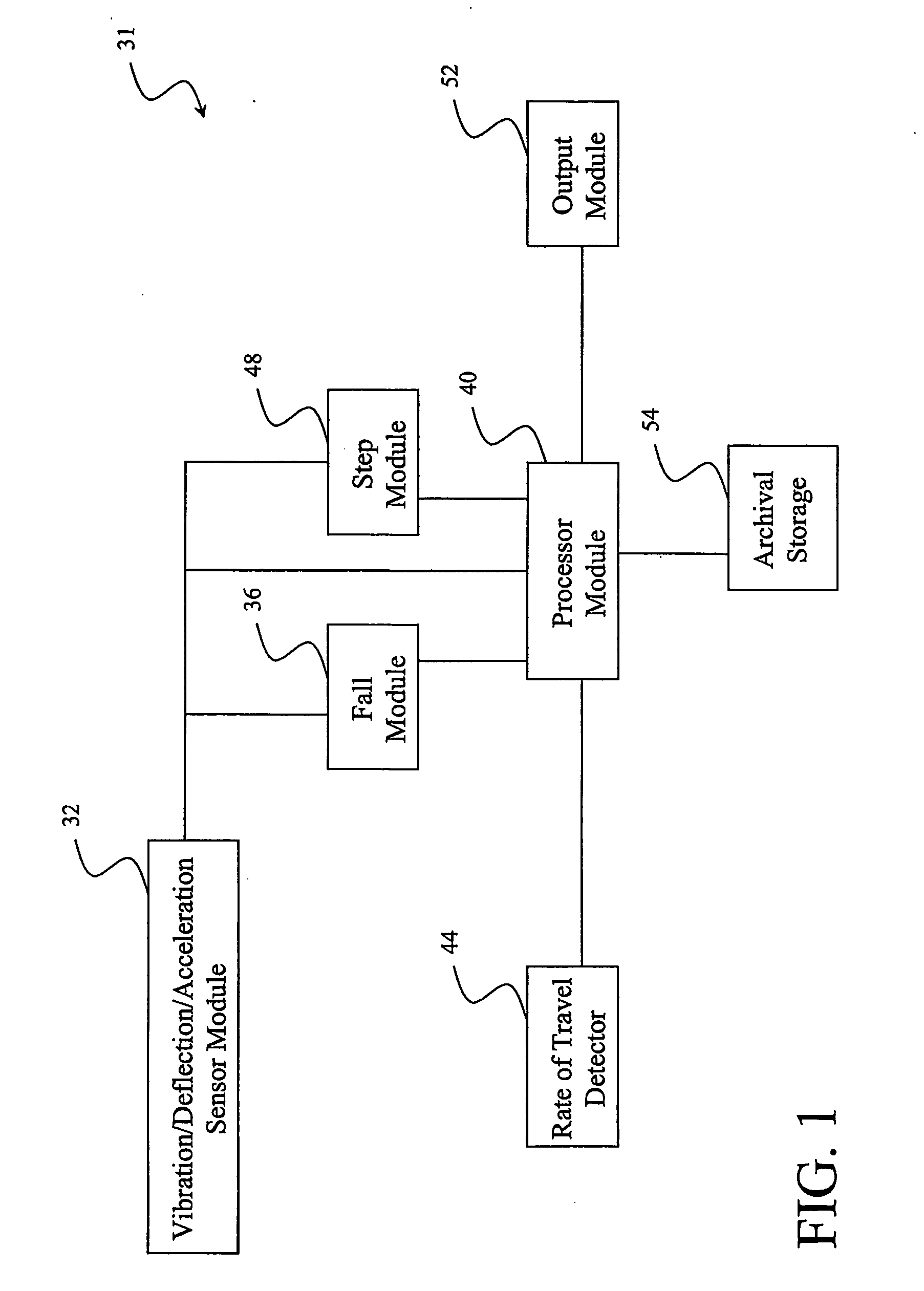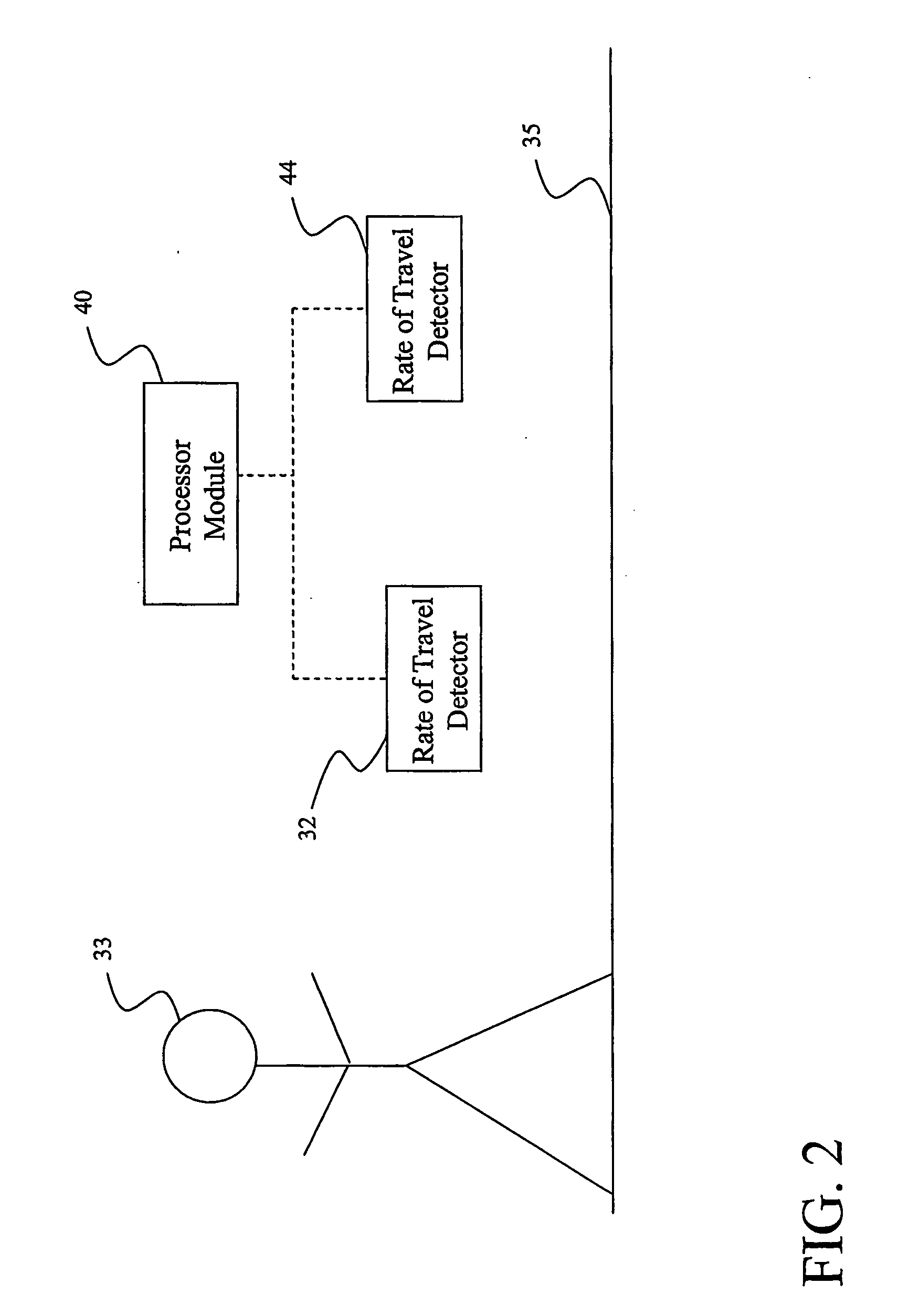Method and system for the derivation of human gait characteristics and detecting falls passively from floor vibrations
a technology of human gait and vibration, applied in the field of human gait characteristics and vibration detection, can solve the problems of impracticality of longitudinal in-home gait monitoring using these technologies, high equipment requirements for functional gait laboratories, and major morbidity in the elderly. , to achieve the effect of heightened fall risk
- Summary
- Abstract
- Description
- Claims
- Application Information
AI Technical Summary
Benefits of technology
Problems solved by technology
Method used
Image
Examples
example no.1
EXAMPLE NO. 1
[0036] FIGS. 3(A)-(B) are schematic plan and elevation views, respectively, of an embodiment of the present invention acceleration, vibration, and / or deflection module 32. Provided is an embodiment of the present invention acceleration, vibration, and / or deflection module 32 that detects floor acceleration, vibration, and / or deflection to provide acceleration, vibration, and / or deflection signal. The gait sensor 32 transduces the displacement of the floor surface 95 into a waveform signal which can be retained and analyzed. The design employs a linear variable differential transformer (LVDT) 92. The LVDT 92 may also be any low mass, high resolution displacement sensor technology including but are not limited to magnetic coil induction; laser light reflection; changes in Plasmon surface resonance; RF; changes in light due to luminescence; doppler radar; and / or any sensor technology that transduces the minute deflections of the floor induced by gait or falling or dropping...
example no.2
EXAMPLE NO. 2
[0038] Referring to FIG. 4, FIG. 4 illustrates a schematic a block diagram of an example of an embodiment of the present invention system 61. In the current embodiment, the fall detection is a separate entity from the step counter 78, which allows the calculation of cadence, and from the limp detector 74 and shuffle detector 72. The fall detector consists of a second order Butterworth band-pass filter (about 30 Hz-50 Hz) 62. This filter was tuned to block frequencies generated by different walk modes or dropped objects and to yield the highest output in response to falling people. However, it should be appreciated that other filter designs, including filter type, order and frequencies, may yield similar results. The filter output feeds into an amplifier and comparator 70 to detect falls; the comparator threshold is tuned to detect a low weight human falling about ten feet (or as desired) from the sensor, yet remain insensitive to dropped objects. This reduces potential ...
example no.3
EXAMPLE NO. 3
[0041]FIG. 5 shows a graphical representation of an example of the results obtained applying an exemplary circuit model to the data obtained from the floor vibration sensor for a normal walk. FIG. 6 shows a graphical representation of an example of the results obtained applying an exemplary circuit model to the data obtained from the floor vibration sensor for a limp. FIG. 7 shows a graphical representation of an example of the results obtained applying an exemplary circuit model to the data obtained from the floor vibration sensor for a shuffle. FIG. 8 shows a graphical representation of an example of the results obtained applying an exemplary circuit model to the data obtained from the floor vibration sensor for a fall.
[0042] Turning to FIG. 5, shows FIG. 5 the graphically shows the signals generated by a person walking in a normal gait mode, together with the derived signals throughout the various processing stages in our circuit model. Knowing the location of the s...
PUM
 Login to View More
Login to View More Abstract
Description
Claims
Application Information
 Login to View More
Login to View More - R&D
- Intellectual Property
- Life Sciences
- Materials
- Tech Scout
- Unparalleled Data Quality
- Higher Quality Content
- 60% Fewer Hallucinations
Browse by: Latest US Patents, China's latest patents, Technical Efficacy Thesaurus, Application Domain, Technology Topic, Popular Technical Reports.
© 2025 PatSnap. All rights reserved.Legal|Privacy policy|Modern Slavery Act Transparency Statement|Sitemap|About US| Contact US: help@patsnap.com



